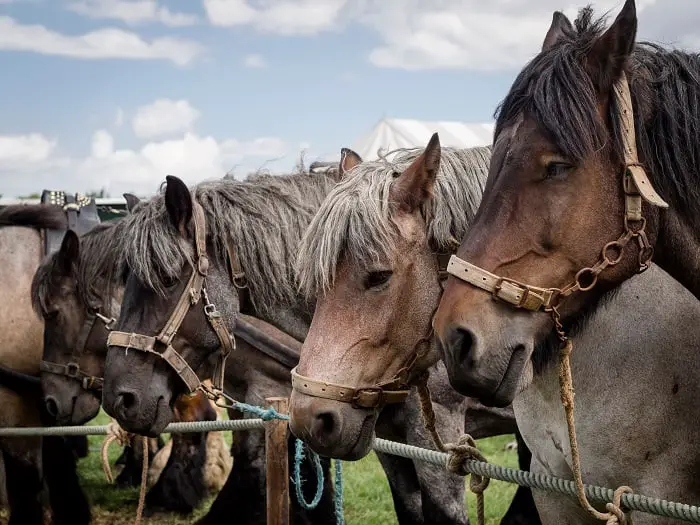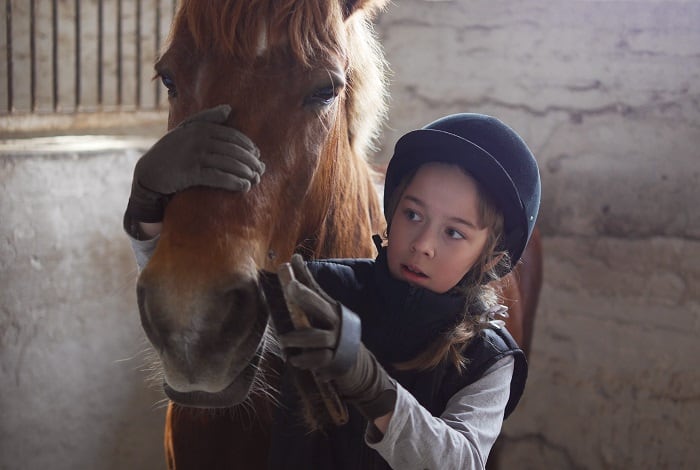Last Updated on March 6, 2023
Two of the equestrian world’s most famous gentle giants are the Belgian Draft horse and the Clydesdale, but when it comes to the Belgian horse vs Clydesdale, there are some big differences! Both of these draft horse breeds have qualities in common and other qualities that are unique to themselves.
Today we are going to explore the similarities and differences in these breeds in terms of coloring and patterns, size, temperament, and much more. Keep reading to find out more about our Belgian horse vs Clydesdale draft horse breed comparison!
Main differences between Belgian Horse vs. Clydesdale
Belgian draft horses are often slightly shorter and stouter than Clydesdales. They are typically larger than Clydesdales, with a head that is smaller and a neck that is shorter. Both breeds are quite robust. Belgian Draft horses can live to around 18 years, while Clydesdales live for 25-30 years.
Belgian Horse vs Clydesdale: Breed History
The Belgian Draft horse and Clydesdale are both draft horse breeds, a term used to refer to horses bred for heavy work such as farming and hauling wagons. However, these two breeds have very different origins!
As the name suggests, the Belgian Draft originated in Belgium and is known to be a direct descendant of the great medieval war horses used to fight battles in Europe in the Middle Ages. These giant stallions were highly prized for their courage, strength, and stamina in battle, but it soon became apparent that these qualities also made them ideal for heavy farm work too.
The breeding of Belgian draft horses can be traced back to the 17th century, and the official stud book was founded in 1886. The popularity of this incredibly strong workhorse spread across Europe and around the world, particularly in the United States. In modern times, the Belgian draft – also known as the American Brabant – is the most common draft horse in the US.
Where do Clydesdale horses come from?
The Clydesdale is originally from Scotland, where it was named after the River Clyde, and the old district of Clydesdale in Lanarkshire. Like most other draft breeds, such as the Shire and the Percheron, the Clydesdale was used for both agriculture and war in the 1800s.
Although the Clydesdale horse is of Scottish origin, it does have something in common with the Belgian draft horse! Both breeds can trace their ancestry back to Flemish horses from northern Belgium. These huge stallions were imported to Scotland to breed with native draft horses, creating the magnificent Clydesdale horses we know and love today.

Belgian Horse vs Clydesdale: Color Comparison
Clydesdale and Belgian Draft horses have very different coloring, making it easy to tell the difference between these two breeds.
Clydesdale horses are famously and most commonly a rich bay color with flashy white feathers. The only other colors accepted by the breed society are brown, grey, roan, and black.
One unusual aspect of Clydesdale horse coloring is the prevalence of white markings. They often have white face markings, extensive white leg markings, and even splashes of white on the belly. These white pattern markings are not commonly accepted in other draft horse breeds, making Clydesdale horses very distinctive.
On the other hand, Belgian draft horses only come in solid colors, without any white markings. The most common color of Belgian draft is bay, and black and chestnut variations are also seen. Grey Belgian draft horses are extremely rare but they can occur.
The most distinctive aspect of Belgian draft horse coloring is the prevalence of the roan coat coloring. This gene creates white hairs interspersed in the base coat color, creating bay roan, blue roan, and strawberry roan coloring. Roan coloring is not seen in many other draft horse breeds, making it easy to spot a Belgian draft horse when you see one.
Belgian draft horses also frequently carry the “mealy gene,” which causes their noses to be significantly lighter than normal. This pattern is relatively rare, and the only other breed in which it is commonly seen is the Exmoor. These markings are often referred to as primitive markings, as they hark back to the prehistoric ancestors of the modern-day domesticated horse.
Belgian Horse vs Clydesdale: Size Comparison
Size is also a distinguishing factor between the Clydesdale and the Belgian. On average, a Belgian Draft will stand between 16-18 hands tall. This is slightly above the height of a normal riding horse, but relatively small compared to some other draft horse breeds.
Clydesdales, however, can stand taller than 18 hands. In fact, in 2009, there was a Clydesdale horse named Poe who stood 20.2 hands tall! They have long legs and powerful bodies, making them ideally suited for hauling wagons and heavy loads.
But just because the Belgian draft horse is smaller, don’t underestimate its impressive size! These horses are famed for their huge muscular bodies and can weigh in at as much as 2,000 pounds. So they might be shorter than the Clydesdale, but they are one of the heaviest horse breeds you will come across.
If you were to stand a Clydesdale horse and a Belgian draft horse side-by-side, you would see that the Clydesdale is taller, with longer legs in proportion to the body. The Belgian draft will have a wider chest and more muscular hindquarters. The other key difference is in the neck – the Clydesdale has a longer neck, while the neck of the Belgian draft is shorter, arched, and very muscular.

Is there a horse bigger than a Clydesdale?
If you look at a Clydesdale horse compared to a regular horse’s height, you will be in no doubt that this horse is a true giant! But while the Clydesdale is one of the tallest horse breeds around, there is another breed that takes the prize for the tallest horse.
The tallest horse ever recorded was a Shire horse called Mammoth, which was recorded to be 21.1 hands high. And the tallest living horse is a Belgian Draft called Big Jake, who measures 20.2 hands high.
So, while Clydesdale is pretty tall, unfortunately, they don’t hold any records for their impressive height!
Belgian Horse vs Clydesdale: Temperament Comparison
You will often hear the phrase “gentle giants” to describe draft horses, including the Clydesdale and the Belgian Draft horse. This is because they are very gentle and calm breeds with a placid temperament which makes them extremely easy to work with.
The Belgian Draft and Clydesdale horse temperament mean they are ideally suited to slow, steady work. They are reliable and even-tempered, with a great work ethic. Belgians and Clydesdales aren’t afraid of much and are always willing to do what is asked of them.
One notable difference in temperament between the Clydesdale and the Belgian Draft is the importance of respect. Belgian draft horse is willing to listen, no matter who is handling them. Clydesdales can be a little pickier; Clydesdales will respond better to someone that they are familiar with and that they trust.
Clydesdales can also be more spirited than Belgians. While both breeds are typically very easy-going, certain circumstances can excite Clydesdales, as they remain gentle and easy to handle, but can get excited, if the situation presents itself.
Belgian Horse vs Clydesdale: What Are They Used For?
When Clydesdales and Belgian Drafts originated, they served a similar purpose. They were dual purpose – used as war animals and for farming. This meant that they carried soldiers into war and also plowed fields. Today, both of those jobs are done by machines, and the two breeds have found new roles in life.
Today the Belgian Draft Horse is most commonly used for driving. If you have ever ridden in a horse-drawn carriage on vacation, there’s a good chance your horse was a Belgian Draft. Belgians are great carriage horses and can pull extremely heavy loads. Sometimes they are even used in pulling competitions, where teams of horses are judged on the heavy loads they can pull.
Belgians, along with the Percheron, are also used as police or security horses. This is because they are not fearful of stressful, crowded, or noisy situations. These horses are steady on their feet and resist physical pressures.
Horse breeders also cross Belgian Draft horses with thoroughbreds and warmbloods to produce various types of sport horses. These Belgian crosses often excel at eventing, foxhunting, dressage, and other athletic equestrian sports.
Today, Clydesdale horses are often used in parades and exhibits, and Clydesdale breed shows are gaining popularity. Clydesdale horses that compete in these shows are judged on conformation, color, and other characteristics that contribute to the breed standard.
One of the most famous groups of Clydesdale horses is the iconic Budweiser Clydesdales, famous across the US for their displays in cities across the country.
Conclusion – Belgian Horse Vs Clydesdale
So, when it comes to Belgian horse vs Clydesdale, it is clear to see that they are both beautiful and gentle giants of the horse world! However, it is clear to see that they have many differences, giving each breed the unique characteristics that they are famous for. The key differences lie in the size and coloring of each breed, making them very easy to tell apart.
We hope this article has helped solve the mystery behind Belgian Horse Vs Clydesdale for you! If it did, or if you have any questions, please feel free to comment and share your draft horse stories with us!
FAQs
Michael Dehaan is a passionate horse owner, horse rider, and lover of all things equine. He has been around horses since he was a child, and has grown to become an expert in the field. He has owned and ridden a variety of horses of different breeds, and has trained many to compete in shows and competitions. He is an experienced horseman, having worked with and competed many horses, including his own. He is an active member of the equestrian community, participating in events and teaching riding lessons.
